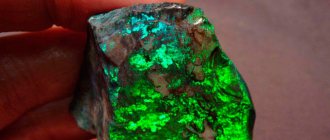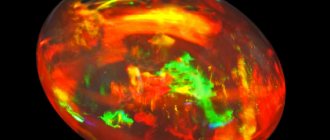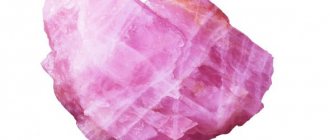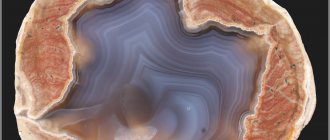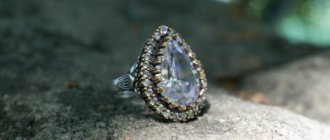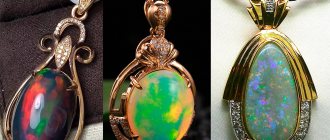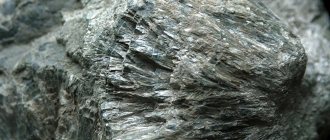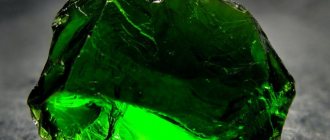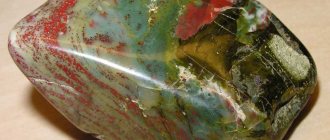/ List of stones / Compatibility of white opal with zodiac signs
0
3410
Article rating
White opal, in addition to its elegant appearance, has healing and magical properties. Its esoteric characteristics show that the stone is not suitable for all people. It depends on the zodiac sign.
Compatibility of white opal with zodiac signs
Description
Opal is a natural stone consisting of silicon oxide and water (from 13 to 30%), therefore, in the scientific sense, it is a kind of gel, subject to drying and cracking. Outwardly it looks like a white or milky-matte stone, with a slight glossy pearlescent sheen.
Scientists call transparent minerals hyalites or milky opals. A distinctive feature of white gems is their iridescent opalescence.
Due to its unusual composition, the properties of white opal differ from other types, so the stone is easily damaged by external factors, which include:
- temperature changes;
- shocks and pressure on the mineral;
- increased dryness;
- exposure to chemicals and fats.
Milk opal is also subject to aging - “old” stones are called chalcedony. To slow down this process, jewelry is worn as often as possible and protected from exposure to harmful factors.
An interesting feature of the gem is its ability to absorb water. If the mineral is placed in a container with liquid, then after a certain time the amount of moisture will decrease. It is important that the water is clean, otherwise the opal will absorb all the dirt and change color.
White minerals are divided into seven varieties:
- hydrofan - a stone of a cloudy white hue;
- cacholong - pearl opal;
- reed - white-milky gem;
- hyalite - transparent crystal;
- milky opal - opaque specimens of white, light yellow or soft green shade;
- girazole - a crystal with a light background and scarlet or blue highlights;
- White opal is the most common type of stone.
The popularity of milky-white minerals in jewelry is high and is due to the wide range of shades and iridescence.
Stone deposits are located in many countries, but the deposits themselves are small in size, so the search for new mining sites is ongoing. Today, the best specimens of white gems are mined in Brazil, Mexico and Turkey.
The stone has fallen - touch the energy of creativity!
Opal The name of this amazing iridescent stone originates from the ancient Indian upala - “precious stone”. Opal was known back in antiquity, and it came to Europe from India. The ancient Roman philosopher Pliny wrote: “Of all the precious stones, it is opal that causes the greatest difficulty in description. It is characterized by the sharp play of light of the carbuncle, the violet reflection of the amethyst, the aquamarine tones of the emerald - all mixed together and shining with indescribable brightness." Opals have such a characteristic and bright color because of their extremely curious structure: in the mineral, water is located between very densely packed tiny globules (balls) of amorphous silica ( SiO 2), in which fragments of a more ordered quartz structure are sometimes found. As a result of the phenomenon of light interference, a recognizable opalescence appears, the color of which depends on the size of the globules. Noble opal, which is characterized by this color, is classified as a precious stone and is highly valued. Ordinary opal can be recognized by its delicate milky shades. It is capable of replacing woody remains, forming petrified trees, and can also develop along other organic remains (for example, filling snail shells).
Opal is the official symbol stone of South Australia.
Varieties of opal
There are several types of opals, but only one of them has a rainbow play of colors: noble opal. Others do not look so impressive, but they are also good:
- Hyalite is slightly harder than other opals. In appearance, it appears as transparent, colorless or faintly colored balls, lumpy formations and masses. It is valued mainly as a collectible mineral.
- Hydrophane is a porous and light variety, quite cloudy when dry, but in water it acquires a play of color and transparency.
- Chrysopal is a green opal that owes its color to nickel ions. When crystallized, it can turn into chrysoprase. They also produce prazopal, which has a more delicate apple-green color.
- Ordinary opal does not have opalescence; it comes in different colors and quite delicate shades. As a subspecies, milky opal can be distinguished - a translucent variety of milky white color. It may contain dendrites of manganese or goethite oxides as inclusions.
- Fine opal is the most famous type of opal. It has a characteristic rainbow play of colors. Among noble opals, separate categories can be distinguished:
- White opal is light, opalescent in blue tones;
- Black opal - the color of the body is dark purple, blue or black, reflections in red and green tones;
- Harlequin is a very expressive multi-color mosaic pattern;
- Fire opal is orange in color from yellowish to red-orange, rather cloudy. There is no opalescence, as in harlequin, but fiery reflections or iridescence are observed in the stone;
- Jirasol is a blue or white transparent variety with soft blue, bluish-orange reflections in the stone.
The formation of noble opals requires compliance with complex geological conditions and their constancy, so they are quite rare. Also, noble opals can develop along cracks in the parent rock (forming, for example, boulder opals ).
It is not entirely correct to classify Cacholong as an opal, since it is a mixture of quartz, opal and chalcedony, and is semi-opal.
Imitations of opals, especially glass ones, have been known since ancient times. The synthesis of opal was first carried out in 1964 in Australia, and in the 1970s in the territories of the former USSR. With this technology, a multi-colored opalescent opal matrix is first grown. They try to make it perfect, so “unpainted” areas in the stone and the uneven arrangement of sparkles are evidence of the natural origin of the stone. Often opal doublets are made, where a thin mineral film is placed on a substrate of cheaper opal, black onyx or a special paste.
To strengthen the opal, stabilization can be carried out - impregnation of the stone with a special colorless resin. This is a measure to protect the mineral, as it is susceptible to cracking.
Geological certificate
The composition of opal is amorphous silica SiO2 nH2O. The mineral contains water - usually up to 5%, but sometimes up to 20% (maximum - up to 34%). Opal often contains mineral impurities, which provide different colors: so an ordinary colorless to white stone is colored in milky blue, gray, red, yellow, green, brown and black tones.
Hardness on the Mohs scale is 5-5.5, hyalite up to 6-6.5. Opal is significantly softer than quartz, although it is composed of the same silicon oxide due to its globular structure. There is no crystalline structure inside the opal; it forms cohesive amorphous masses.
The largest known deposit of precious opals, especially black ones, is found in Australia; opals are also mined in the Czech Republic, USA, Brazil, Russia (in Kamchatka in very small quantities); The place of development of fire and ordinary opals is Mexico, Peru, Brazil, Kazakhstan, Turkey.
Healing properties of opal
Opals are good for depression, insomnia, fainting, and nervous disorders; Wearing them helps achieve spiritual harmony and balance. The stone is good for cardiac activity, has a positive effect on vision, and helps get rid of eye diseases. Women often wear opals to relieve infertility. Opal also helps strengthen the immune system, and it is believed that it can lose its luster if the owner begins to fall ill.
Magic properties
Even the ancient Romans noted that wearing opals brings good luck and drives away fears. This stone is strong enough to protect the owner from the evil eye and theft, bring him happiness and love, and reveal the gift of foresight. White
opal symbolizes purity of soul and patience,
black has significant inner strength, and therefore is able to persuade the owner to a riotous lifestyle. Many claim that this opal helps only mentally strong people. Milky and yellow opals give a feeling of unity and harmony in the surrounding world, strengthening the spiritual aspirations of the owner. In India, opals were given to young children to help them grow.
Feng Shui and Vastu Shastra
According to Feng Shui, opal has projective Yang energy, weakens the element of Fire and strengthens the element of Water. In the Vastu Shastra , opal can serve as a substitute for other precious stones, depending on the color. Opal also has a good effect on all chakras, also depending on the color of a particular stone.
For zodiac signs
Opal is well suited for the signs of Pisces, Cancer, Libra, Capricorn. At the same time, in Pisces he will develop caution and the ability to anticipate negative situations in advance.
Opal is contraindicated for Aries.
Amulets and talismans
Opal is considered a good talisman for people who want to radically change something in their life; for creative individuals - as it develops their talents and abilities; also for healers - doctors and psychotherapists. This bright gem is also good as a love amulet, helping its owner in organizing his personal life.
Since opal is not a very hard mineral, the opal cabochon is often made not to protrude from the frame, but to sit deep in it to avoid mechanical damage. White opal set in gold enhances its influence many times over. Wearing a ring or ring on the index finger promotes strong relationships with relatives and loved ones.
Opal can be worn in combination with stones such as aquamarine, beryl, topaz, malachite, agate, garnet, sapphire, onyx, jade, tourmaline, rock crystal, chrysoprase, carnelian, amethyst, ruby. This is a very water-loving stone - it can dry out and crack, losing it, so it is recommended to store opal jewelry in high humidity, or even completely in water. For the same reason, opal should be worn as often as possible, since the mineral will get the missing moisture from the environment (or from the owner’s skin). You should not allow the stone to overheat strongly under the rays of the sun or electric lamps, and sometimes you should put it in clean, cool water to restore it.
Other products made from this stone:
Opal stones Opal beads Opal bracelets Opal earrings Opal pendants and pendants Opal rings Opal balls Opal hearts Opal druses Opal tumbling Opal sections Opal samples Opal steles Opal brooches Opal keychains Opal cabochons Opal eggs Opal cutting Opal beads Jewelry made from stones opal Products made from opal stones
Magic properties
White opals, like many natural stones, are associated with magic and the occult. The light color of the mineral indicates its positive energy, and the gem itself has been nicknamed the “stone of knowledge” for its ability to awaken a craving for learning and books.
According to esotericists, milk opal can become attached to the owner when worn frequently and provide support and protection, working as a talisman. Gems are often used in rituals and ceremonies, as they contribute to the development of intuition and paranormal abilities.
List of other magical properties of the mineral:
- heightens emotions and sensuality;
- protects and protects from damage and the evil eye;
- helps to become more tolerant and kinder;
- bestows with determination.
Esotericists recommend wearing milky-white gems to doctors or nurses, since the stone develops mercy and kindness in the owner.
It would also be useful for teachers, lawyers, teachers and educators to have jewelry with opal.
Origin story
Opals are a product of post-volcanic activity. Mostly they originate after the outpouring of lava flows. Placers are formed especially often if volcanic activity is accompanied by the appearance of geysers.
Water masses containing large amounts of impurities are heated and pushed out of magma chambers under high pressure. This leads to the formation of opal crystals in cracks and on the earth's surface.
Large deposits of this mineral are not found. Stones are found among other rocks. Such inclusions are especially often present in agate veins.
Opal will also form under exogenous conditions, when silicates decompose against the background of weathering of rocks of different compositions. In this process, silica, released during the destruction of crystalline structures, forms ash, which coagulates in the form of sinter nodules.
These formations, together with aluminum, iron hydroxide and other substances, replace areas of bedrock.
Water opals are classified into a separate group. Such stones are formed by coagulation of the skeletons of diatoms and some other organisms. In some areas of the seabed, the remains of these creatures form wide layers of mineral.
In addition, it is possible that opals may fall out in the coastal zone of salty bodies of water due to the coagulation of silica brought by rivers from the land.
There are many myths and legends that explain the appearance of the gem. In Ancient Greece, it was believed that opals were the tears of Zeus, which he shed on the ground after his victory over the Titans.
The indigenous peoples of Australia associated the mineral with the supreme gods. It was believed that rainbow stones are the remnants of traces of the Creator of the world, who once descended to Earth to see how people live.
In Arab countries there is a myth that the stone is formed where lightning strikes. It was recommended to keep it in the house for protection from natural disasters.
In India there is a legend according to which the goddess of the rainbow broke up into gems to escape the attention of her fans. Some indigenous peoples of Africa believed that through opal the gods were able to hear and see, and also convey their will to people. Altars were decorated with stone, and eyes for idols were made from it.
Medicinal properties
In ancient times, natural milky opal was considered a gift from heaven and was actively used to treat serious diseases such as infertility and loss of vision. In the East, the mineral was given to newlyweds for their wedding, in the hope that the newly-made family would sooner have a child.
One of the most useful and unique healing properties of the stone is its ability to “diagnose” the health status of the owner. If the white opal has changed color, faded or lost its iridescence, then such changes foreshadow the development of an illness in the human body. Healers and magicians claim that this is how the gem tries to protect the owner from stress, illness or damage.
Healing properties of white stone:
- improves vision;
- normalizes metabolism;
- increases stress resistance;
- lifts the mood;
- eliminates infertility;
- calms the nerves;
- restores vitality;
- enhances positive emotions;
- promotes the removal of waste and toxins from the body;
- slows down the aging process.
Who is suitable according to their zodiac sign?
White opal is ideally compatible with Pisces, Cancer and Scorpio. The mineral will protect, protect, and endow representatives of these zodiac signs with developed intuition and communication skills.
The gem is a suitable amulet for Libra and Aquarius. The stone will help them improve their financial situation, establish work connections and build a career. Aries and Sagittarius need to wear milky opal with caution, since the mineral does not tolerate aggression and hot temper, which is what distinguishes these signs of the zodiac circle.
Capricorns should refrain from wearing a white stone, since their talisman is another type - fire opal.
All other zodiac signs can wear the milky gem as jewelry, but not too often.
Compatibility with other minerals
Opal pendant
Opal is a water gem, and accordingly, it has the best union with its fellow elements. The compatibility of opal with Earth stones will also be ideal - the unique properties of both in “team work” will manifest themselves to the maximum extent. Opals can and should even be combined with:
- Coral.
- Aquamarine.
- Hashenite.
- Euclase.
- Jade.
- Sarder.
- Melanitis.
- Emerald.
- Aventurine.
- Turquoise.
- Jasper.
You should not combine opal with air or fire stones in jewelry. In the first case, gems will conflict, creating negative vibrations for a person, in the second, they will simply “put out” each other, turning from magical stones into beautiful trifles.
Opal has negative compatibility with:
- Diamonds (diamonds).
- Rubies.
- Pyrope.
- Amethysts.
- Rock crystal.
- Hyacinth.
- Pomegranate.
- Chrysoprase.
Application
Milk opals are widely used in jewelry due to the variety of shades and unique beauty. They are used to make jewelry and decorative items. Transparent minerals such as hyalite are cut into convex round, oval or fancy shapes, while white ones are cut into cabochons.
The material for the frame is only noble metals - gold or silver. The final cost of jewelry with opal depends on the variety and deposit of the gem. It should be noted that the jewelry industry uses only precious species, the extraction of which is very difficult.
Decorative or interior items are created from natural semi-precious minerals or specimens with flaws, for example, stands, various figurines, boxes, vases and much more.
White opal is an iridescent original stone with magical and healing properties. Wearing jewelry will help emphasize the individuality of the owner, and will also protect him from negative energy and accidents, if you do not forget to take care of the mineral.
Patent and common counterfeits
The first patent for the production of synthetic opals was received by researchers Gaskin and Dorre (Australia). At the end of the 18th century, imitation gems began to be produced on a commercial scale in Switzerland. Their prices are several times lower than for natural ones, and it is quite difficult to distinguish a fake. In the last century, with the advent of nanotechnology, methods for creating stones with opalescence appeared.
It is now difficult to distinguish a natural gem from a fake. But you can try:
- A synthetic stone does not provide that magical play of light - the opalescence that occurs precisely in the depths of the gem.
- Imitation is always brighter, catchier, and more vulgar in color.
- Doublets and triplets can be identified using a magnifying glass - it will help identify the joints, seams between the natural opal plate and the base.
Important: painting white opals black and impregnating stones with synthetic resins is considered a fake.
Trade in doublets and triplets is allowed in jewelry stores. They cannot be called real stones, but they are not completely fake.
A doublet is a thin plate of a gem glued to an opaque base.
A triplet consists of three parts. The “lid” is made of transparent quartz, the opal plate and the backing are made of opaque material.
